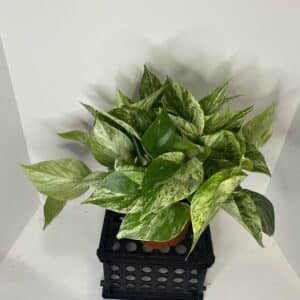
The marble queen pothos is a popular plant in the hardy pothos family. All members of this group have glossy, heart-shaped, leathery leaves but in different colors. The golden pothos is yellow and green, the jade pothos is solid green, and the marble queen pothos is green and white.
All pothos plants are efficient in cleaning the air of harmful chemicals.
A marble queen pothos survives in low light but looks better and grows faster in medium to bright indirect light. When the light is too low, the white swirls on the leaves revert to green on the new growth.
Marble queen pothos like their soil to be kept on the dry side. During the spring and summer, water well and then allow the top 50% of the soil to dry out before watering again. During the fall and winter, let the soil get almost totally dry before watering. If in doubt, wait for the leaves to become soft and droop a little before you water. Black leaves indicate over watering while bright yellow leaves mean the plant has gotten a bit too dry before you watered.
The best temperature is between 65°F-85°F (18.3°C-29.4°C) The leaves may be damaged if the temperature drops below 55°F ( 12.8°C).
Marble Queen pothos grow well in basic household humidity.
All pothos plants are relatively pest free. Although thrips and Mealy Bugs may be a problem.
Bacterial Leaf Spot Disease causes dark spots with yellow halos. Keeping the leaves dry helps prevent bacterial diseases. Root rot and stem rot fungal diseases cause stems and roots to become mushy and die. These problems need to be treated with a commercial Fungicide and correcting how you are watering the plant.
A marble queen pothos likes to be root-bound in a small pot. When the roots have filled the existing pot, move to the NEXT size pot and nothing larger.
Aggressively trim the long vines every few months to keep your plant full and bushy. You can use the stem tip clippings to easily start new plants.



